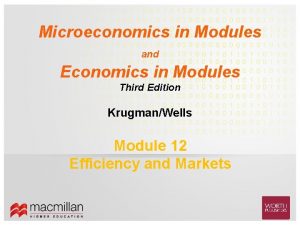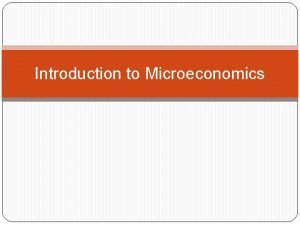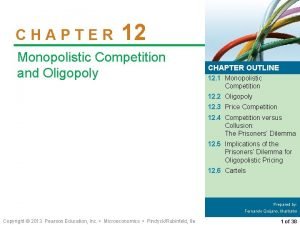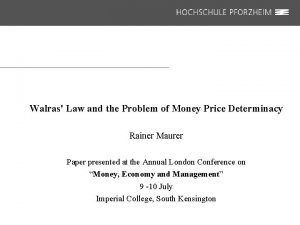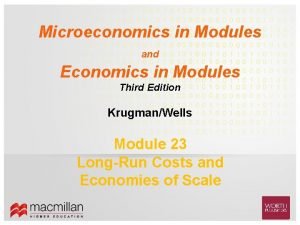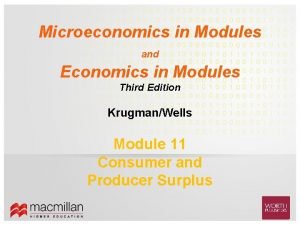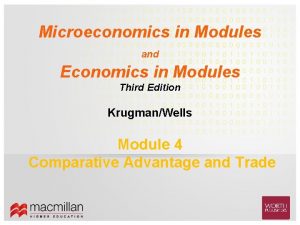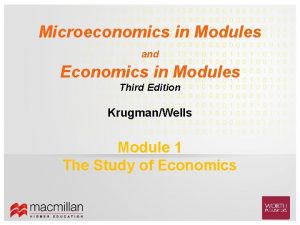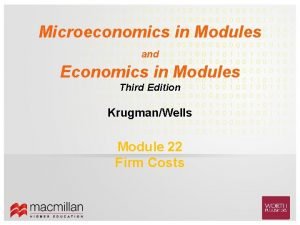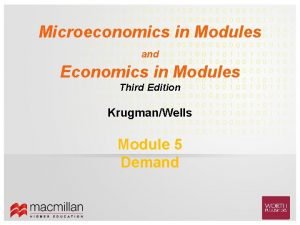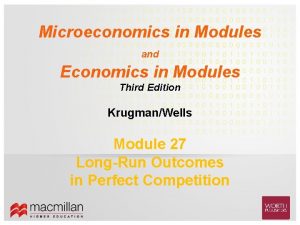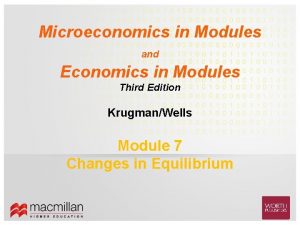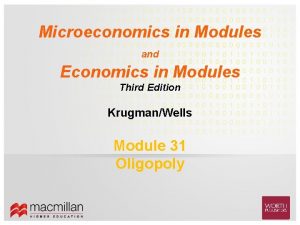Microeconomics in Modules and Economics in Modules Third















- Slides: 15

Microeconomics in Modules and Economics in Modules Third Edition Krugman/Wells Module 10 Other Elasticities

What You Will Learn How the cross-price elasticity of demand measures responsiveness of demand for one good to changes in the price of another good 2 The meaning and importance of income elasticity of demand, which measures responsiveness of demand to changes in income 3 The significance of the price elasticity of supply, which measures the responsiveness of the quantity supplied to changes in price 4 The factors that influence the size of these various elasticities 1 2 of 16

Other Elasticities • The cross-price elasticity of demand between two goods measures the effect of the change in one good’s price on the quantity demanded of the other good. It is equal to the percent change in the quantity demanded of one good divided by the percent change in the other good’s price. The cross-price elasticity of demand between goods A and B 3 of 16

Cross-Price Elasticity • The cross-price elasticity of demand for substitutes is positive. • The cross-price elasticity of demand for complements is negative. 4 of 16

The Income Elasticity of Demand • The income elasticity of demand is the percent change in a good’s quantity demanded when a consumer’s income changes divided by the percent change in the consumer’s income. 5 of 16

The Income Elasticity of Demand • A normal good has a positive income elasticity of demand. – The quantity demanded at any given price increases as income increases. • An inferior good has a negative income elasticity of demand. – The quantity demanded at any given price decreases as income increases. 6 of 16

Economics in Action Will China Save the U. S. Farming Sector? • In the 1940 s, 17% of the U. S. population lived on farms. In 1991, only 1. 9% did. Why? • First, the income elasticity of demand for food is much less than 1, so it is income inelastic. Therefore, the share of income spent—and earned by farmers—on food has fallen. • Second, the demand for food is price-inelastic, so drops in prices of agricultural goods, other things equal, reduce the total revenue of farmers. • But increased demand for food products from growing and developing countries like China has increased agricultural prices and increased farmers’ incomes. 7 of 16

The Price Elasticity of Supply • The price elasticity of supply is a measure of the responsiveness of the quantity of a good supplied to the price of that good. • It is the ratio of the percent change in the quantity supplied to the percent change in the price as we move along the supply curve. 8 of 16

Two Extreme Cases of Price Elasticity of Supply (a) Perfectly Inelastic Supply: Price Elasticity of Supply = 0 (b) Perfectly Elastic Supply: Price Elasticity of Supply = ∞ Price of cell phone frequency Price of pizza S 1 $3, 000 An increase in price… 2, 000 0 … leaves the quantity supplied unchanged. 100 At exactly $12, producers will produce any quantity. At any price above $12, quantity supplied is infinite. $12 S 2 At any price below $12, quantity supplied is zero. Quantity of cell phone frequencies 0 Quantity of pizzas 9 of 16

The Price Elasticity of Supply • There is perfectly inelastic supply when the price elasticity of supply is zero, so that changes in the price of the good have no effect on the quantity supplied. • A perfectly inelastic supply curve is a vertical line. • There is perfectly elastic supply when even a tiny increase or reduction in the price will lead to very large changes in the quantity supplied, so that the price elasticity of supply is infinite. • A perfectly elastic supply curve is a horizontal line. 10 of 16

What Factors Determine the Price Elasticity of Supply? • Availability of inputs: The price elasticity of supply tends to be large when inputs are readily available and can be shifted into and out of production at relatively low cost. It tends to be small when inputs are difficult to obtain. • Time: The price elasticity of supply tends to increase as producers have more time to respond to a price change. This means that the price elasticity of supply is often higher in the long run than in the short run. 11 of 16

An Elasticity Menagerie 12 of 16

An Elasticity Menagerie 13 of 16

Summary 1. The cross-price elasticity of demand measures the effect of a change in one good’s price on the quantity demanded of another good. 2. The income elasticity of demand is the percent change in the quantity demanded of a good divided by the percent change in income. 3. If the income elasticity is greater than 1, a good is income elastic; if it is positive and less than 1, the good is income-inelastic. 4. The price elasticity of supply is the percent change in the quantity of a good supplied divided by the percent change in the price. 14 of 16

Summary 5. If the quantity supplied does not change at all, it is perfectly inelastic supply; the supply curve is a vertical line. 6. If the quantity supplied is zero below some price but infinite above that price, it is perfectly elastic supply; the supply curve is a horizontal line. 7. The price elasticity of supply depends on time and on the availability of resources to expand production. It gets higher over time and is higher when inputs are available at relatively low cost. 15 of 16
 Economics modules
Economics modules Forward caries and backward caries
Forward caries and backward caries Forward caries and backward caries
Forward caries and backward caries Maastricht university school of business and economics
Maastricht university school of business and economics Principles of economics third edition oxford pdf
Principles of economics third edition oxford pdf Pure public good
Pure public good Examples microeconomics
Examples microeconomics Definition of macroeconomics
Definition of macroeconomics Non mathematical economics
Non mathematical economics Copy
Copy What is the subject matter of microeconomics
What is the subject matter of microeconomics What is microeconomics
What is microeconomics Intermediate microeconomics lecture notes
Intermediate microeconomics lecture notes Intermediate microeconomics notes
Intermediate microeconomics notes Cartel microeconomics
Cartel microeconomics Walras's law
Walras's law
